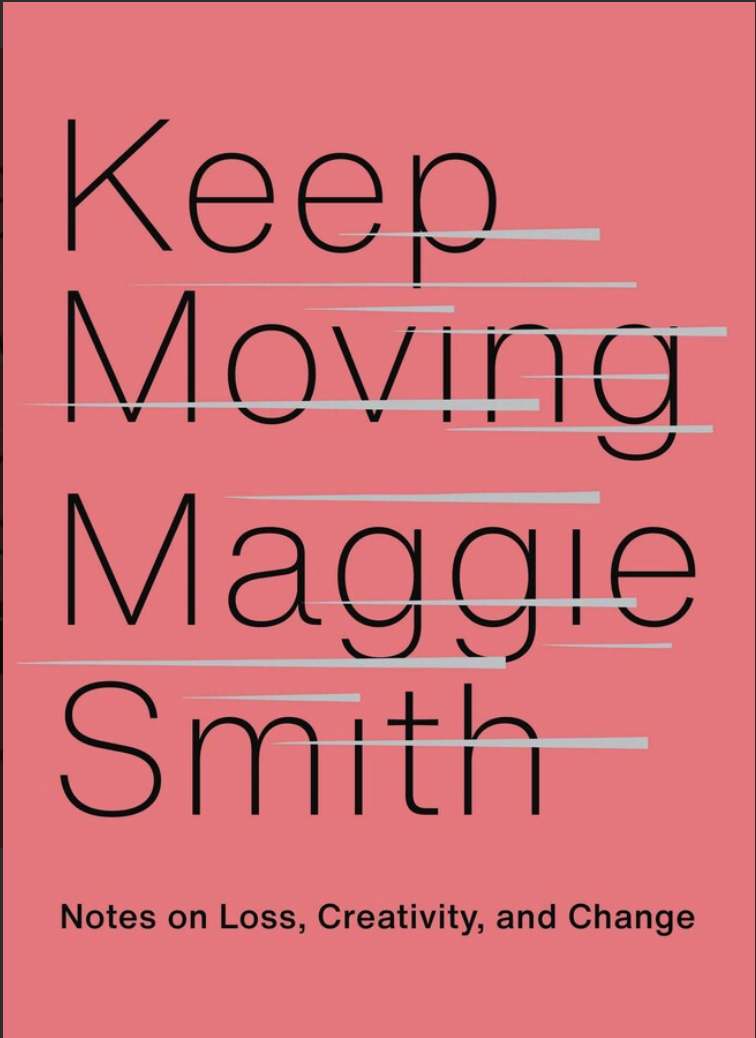Right now, on some corner of social media, someone is sharing Maggie Smith’s “Good Bones.” A wildfire in 17 lines, it was named “the official poem of 2016” by Public Radio International. “Good Bones” expressed the sensation—a slight shiver in any year, a palpable throbbing in that one—of living in a fixer-upper world.
Last year, Smith created another deeply humane offering with Keep Moving. In the days after her marriage ended, she perceived “so many blank pages, so many blank years ahead, to fill.” Smith occupied the spaces—and herself—with a series of short affirmations, resolutions, and prayers to and for oneself. Encountering her hopeful habit on social media, readers testified she had channeled the spirit of a moment once again. Her words resonated with souls wrecked by four long years of political and interpersonal demolition, yet ready to come alive again.
Collecting Smith’s witness, Keep Moving extends the work of “Good Bones,” making “this place beautiful” one person at a time, inside out. These brief dispatches, divided and fulfilled by companion essays, retain the soft resilience of poetry. But they read like permission slips—to exist in and beyond heavy spiritual labor, becoming receptive yet deliberate, progressively adept at absolving your own mistakes and trusting your instincts.
The Curator caught Smith at an interval between Keep Moving and her forthcoming collection Goldenrod (set for a late July release), to learn more about how she remains in motion.
*
Aarik Danielsen: There isn’t necessarily a particular religious center to Keep Moving, but I sense a liturgical momentum through these pages. I can imagine a reader spending time with a page or two daily, or even returning to certain passages seasonally, as if following the church calendar. Does that ring true to you at all? What value or power might these words gain with repetition or intention and routine?
Maggie Smith: When I write, I’m having a conversation with my own mind. Writing a book is a way of communing with the self in a way that is, ideally, not closed or ego-driven or “all about you,” but instead connects you to others and to the world. If a book feels intimate, it’s at least in part because the writing of it was an intimate process. I think that intimacy translates.
I didn’t have a specific reading experience in mind for Keep Moving, but what I hear from readers is that they’re engaging with the book in different ways. Some read it in one sitting, while others are reading a page or two or three a day. I have returned to the book this year by simply opening to a page or flipping through until I found something that applied to my life or just my day. The challenges I’m experiencing now are different from the challenges that inspired the book, but I’m still finding the notes-to-self useful. I think we all need reminders of what is possible on the other side of deep loss and difficulty. I know I need those reminders now.
AD: What books—or other works of art, film or music—do you return to in a habitual or liturgical fashion, relying on them for regular affirmation or inspiration in season?
MS: I tend to read novels or memoirs once or twice, but I return to books of poems again and again. Over the past year I’ve found myself returning again and again to books by Victoria Chang, Lisel Mueller, Barbara Ras, Ross Gay, Stanley Plumly, Carrie Fountain, Yehuda Amichai, Michael Bazzett, Kathy Fagan, Ellen Bass, Matthew Olzmann, Joanna Klink, and many others. I can reread the collection in one burst or, more likely, revisit it one or two poems at a time. I often go to my shelves, pull out a book, and find a poem—or even simply a line or an image—that speaks to me in that moment. When you think about it, the single poem is a perfect, self-contained reading experience.

AD: No doubt, the words of Keep Moving became conviction and creed to you as you wrote them. But now that they’re out in the world, do you feel any added pressure to live out or live up to them? On a daily basis, do they feel more aspirational or ingrained and settled?
MS: A friend of mine recently texted to say his therapist had recommended Keep Moving to him. He joked to the therapist that next time we talked, he’d ask me if I stand by my advice. The thing is, I do stand by my advice—the advice I was giving to myself a couple of years ago—but I wouldn’t say those notes-to-self are ingrained and settled. We can know, logically, the right thing to do but still have a hard time doing it. When I read the quotes again now, I often remember the headspace I was in when I wrote them. The emotional weather might be different now, but the sentiments still apply. I have good days and bad days—and good hours inside bad days, and bad hours inside good days—like everyone else. We are all just trying.
AD: There are so many soulful moments throughout this book where you overlay the writing process with the process of revising or remaking your whole life. Did those points of overlap come naturally or did you have to learn to see them? How might people who gravitate toward other acts of creation and cultivation (music, painting, farming, et al.) more intentionally discover those parallels for themselves?
MS: The metaphor is so often right there for us, waiting. We say “life story.” We talk about healthy vs. unhealthy narratives. We often talk about life as a journey, and as illness as a battle. All of this is metaphor, but it’s so ingrained in our thinking, so natural, we don’t see it as poetic thinking.
Making comparisons is one way we can help others understand what we’re feeling. If you haven’t been through what I’m going through, I can try to help you get it by drawing a comparison to something closer to your experience or something more universal. When my marriage ended, it was natural for me, as a poet, to articulate my experience using metaphors of loss and destruction—burning, decaying, breaking—but also more hopeful metaphors of recovery, rebuilding, and regrowth. We can all access metaphor to help us make sense of our experiences and to communicate them to others, whether or not we are artists. The language is right there, waiting for us.
AD: Keep Moving has the lyrical appeal and rhythm of poetry, but takes on the traits of other genres. How did the actual writing of this book compare to writing something like, say, [the 2017 collection] Good Bones? Did you interact with space—your physical workspace or headspace—any differently than you do when writing poetry?
MS: I wrote Good Bones the same way I write any collection of poems—one poem at a time over many years, without having a sense of the book those poems will someday live in and call home. But as I write individual poems, I do think—hope, really—that they will someday be part of a book. Keep Moving happened in a much different way. I wrote the quotes one by one, like poems, but without the expectation that they would be in print one day. My thinking about the project only changed when people on social media began asking for a book, expressing that they wanted to have the quotes collected in that way. The process of writing the essays was different from writing poems, certainly, and I write about that in Keep Moving. I had more space in prose, first and foremost, and was able to stretch my legs a little more inside those essays as opposed to inside my poems, which tend to be fairly concise and compact.

AD: I feel like I’d be remiss if I didn’t ask about “Good Bones,” the poem. That work has a rare staying power most poems just don’t achieve. Writers can’t live or die by the reaction they receive, but do you feel the response of readers has changed your own relationship to that poem? Does the meaning they find stick to your own sense of what it is, or are you still able to access that time and place when it was just you and the poem?
MS: The poem feels like public domain work to me at this point—less personal and intimate to me than my other poems. I think this is probably because of how far the poem has traveled and how many readers have interacted with it (and reacted to it), but I also think it’s inherently less personal as a poem. Many of the poems in Good Bones reference my house, my street, my town; they even include dialogue from my kids. “Good Bones” doesn’t do any of that, and so perhaps it was more universal from the start.
AD: In so many ways, attention seems to be the work of the poet. To pay it at a moment’s notice, and call others to invest it too. In Keep Moving, you write: “When the present nudges me, Come along now, I write as a way of coming along. I write as a way of creating spring regardless of the heart’s—or world’s—season.” How is the present nudging you now? Where do you sense yourself being beckoned to come along now and cast your attention?
MS: I agree—paying attention is an integral part of any artist’s work. This past year has been difficult for many different reasons. I’m single parenting two children on two different school schedules during a pandemic, and I’m doing my best right now to stay present with them and to be available while also not losing myself in the mix. It’s a balance I’m better at some days—and some hours—than others. Part of what is helping me stay grounded and calm is not thinking too far into the future and not dwelling too much on the past. Mindfulness, yes? Right now I’m most invested in my family and in my writing—and in this sense, regardless of current challenges, my priorities are what they’ve always been. So much is changing, yet so much remains the same. I find solace—and fortitude—in that.
You can find Smith’s books on Bookshop.org:
- Good Bones
- Keep Moving
- Goldenrod (preorder)
If you purchase a book through one of our Bookshop.org affiliate links, we may earn a commission that helps support our work — and ultimately pay our contributors. You’ll also be supporting independent bookstores across the country.




